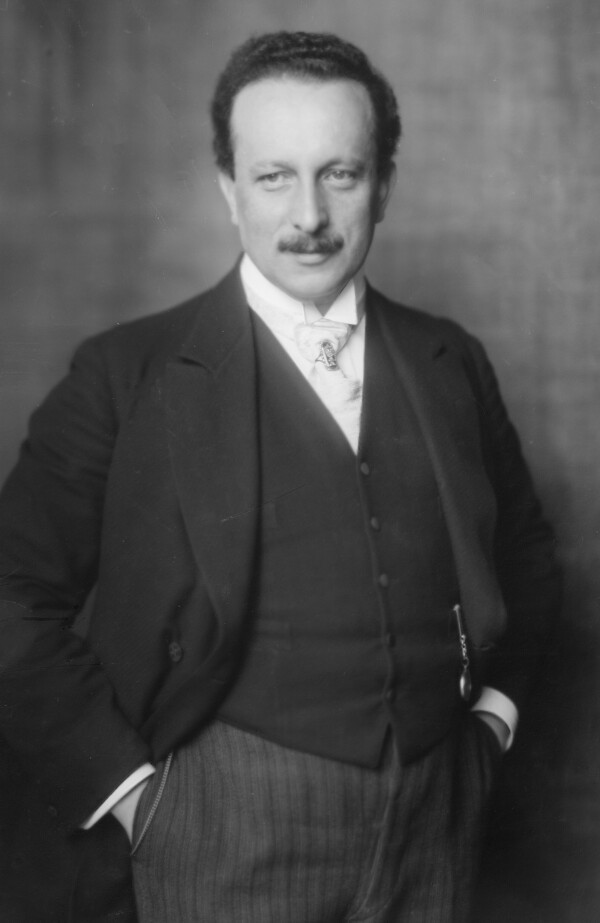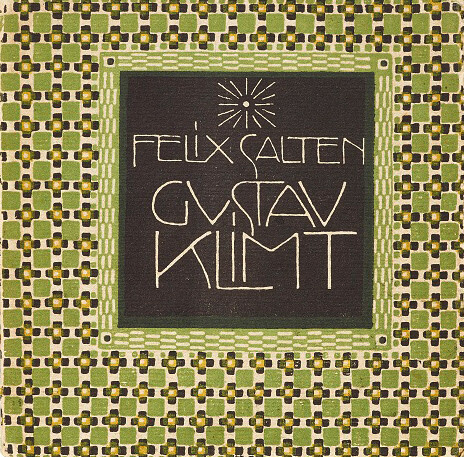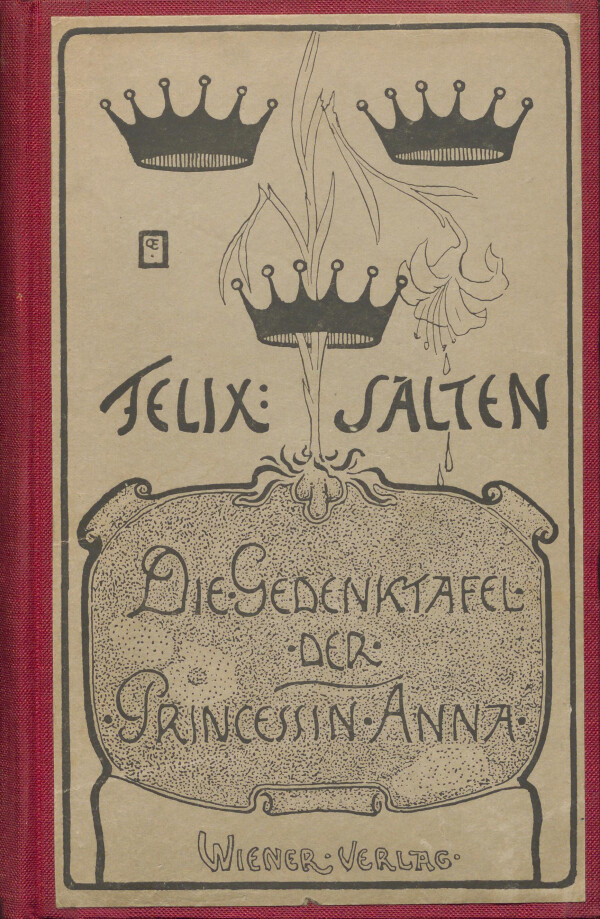Felix Salten

Felix Salten photographed by Madame d'Ora, 1911, Austrian National Library, Vienna
© Picture Archives and Graphics Department, Austrian National Library

Felix Salten: Gustav Klimt – Gelegentliche Anmerkungen. mit Buchschmuck von Berthold Löffler, Leipzig 1903.
© Klimt Foundation, Vienna

Felix Salten: Die Gedenktafel der Prinzessin Anna, Vienna and Leipzig 1902, Wienbibliothek im Rathaus
© Vienna City Library, Manuscript collection
Felix Salten was an Austro-Hungarian writer, journalist, and member of the Jung-Wien literary circle. As an art critic he stood up for Gustav Klimt. His famous work Bambi achieved worldwide fame primarily through the Walt Disney film adaptation.
Felix Salten was born into a wealthy Jewish family as Siegmund Salzmann in Budapest on 6 September 1869. The family soon moved to Vienna. His father Phillip having lost the family’s fortune through speculation, Felix dropped out of the Wasagasse Grammar School to work for an insurance company. At the same time, he published poems and reviews under the pseudonym of Felix Salten.
Starting in 1890, he frequented the Jung-Wien circle with Hugo von Hofmannsthal, Arthur Schnitzler, Richard Beer-Hofmann, Hermann Bahr, and Karl Kraus, who was a regular at the Café Griensteidl. Initially, he had become a close friend of Schnitzler and Kraus in particular. However, around 1894, Kraus and Salten fell out with each other. In addition to the unpleasant end of Salten’s affair with their mutual acquaintance, the feminist Charlotte Glas, envy and competition are also likely to have played a major role. From this point, Karl Kraus repeatedly attacked his former friends in his literary reviews. In 1902, Salten married the actress Otilie Metzl, whereupon his numerous affairs came to an end. The couple had two children, Paul Jakob and Anna Katharina.
Felix Salten as an Art and Theater Critic
Salten was employed as an art and theater critic by the Wiener Allgemeine Zeitung. From 1894 on, he worked for Die Zeit and published his texts in many well-known literary journals. In his reviews he fought anti-Semitism and supported the newly founded Vienna Secession and its exhibition program.
In 1901, Salten, together with Hermann Bahr, initiated the first literary cabaret Jung-Wiener Theater zum lieben Augustin at the Theater an der Wien, which, however, was short-lived. He had the posters, stage sets, and costumes designed by Kolo Moser.
In 1903, on the occasion of the “Gustav Klimt Collective Exhibition,” he published his brochure GUSTAV KLIMT, in which he described the artist as a pioneer, leader, and programmatic artist. He also defended the Faculty Paintings and advocated Klimt’s “break with iconographic conventions.” He praised Klimt’s image of women, their sensual depiction, and the modernization of Old Testament iconography based on the painting Judith I (1901, Belvedere Vienna).
Salten’s assessment of a portrait photograph of Klimt by Friedrich Viktor Spitzer from 1907 shows his personal image of the artist of the century:
“Look at Gustav Klimt’s head, how everything is brought out here: the masculine freshness of this master, the fullness of his nature, his inner, almost childlike serenity, and his pensive seriousness. And you will find that one can hardly speak of photography here.”
Salten’s initial enthusiasm for modern art was to be increasingly inhibited over the years by a need for conventional aesthetics.
Principal Works and War Years
In 1906, the well-known work Josefine Mutzenbacher oder Die Geschichte einer Wienerischen Dirne [“Josefine Mutzenbacher or The Story of a Viennese Whore”], now attributed to Salten, was published under the cloak of anonymity. The scandalous work was initially only sold in a private edition, but was soon reprinted and reissued, partly as a censored version.
Other well-known works by Salten include Wurstelprater, with 75 photographs by Emil Mayer, and his world-famous animal story Bambi – A Life in the Woods, which was published in 1923 and purchased at a low price by Walt Disney in 1942 to be made into a movie. From 1913 to 1918, Salten also worked as a screenwriter and director in the film industry.
During World War I, Salten served in the war archives. Initially enthusiastic about the war, his positive attitude changed in 1917. Salten campaigned for the preservation of Austria’s cultural heritage. In 1927, for example, he criticized the Austrian state’s rejection of the Figdor art collection in Vienna as an inheritance, which was presumably declined for anti-Semitic reasons. In the coming years, Salten was president of the Austrian PEN Club, which promoted an international intellectual exchange among writers, until his books were prohibited by the Nazi regime in Germany in 1933.
One year after Austria’s “Anschluss” in 1938, Salten fled Vienna with the help of his daughter and spent the rest of his life in Zurich, where he wrote a sequel to Bambi (Bambi’s Children), as well as other animal books. Salten died in Zurich on 8 October 1945 and was buried there at the Israelite Cemetery.
Literature and sources
- Österreichisches Biographisches Lexikon. Felix Salten. www.biographien.ac.at/oebl/oebl_S/Salten_Felix_1869_1945.xml (03/26/2020).
- Wien Geschichte Wiki. Felix Salten. www.geschichtewiki.wien.gv.at/Felix_Salten (03/26/2020).
- Manfred Dickel: »Ein Dilettant des Lebens will ich nicht sein«: Felix Salten zwischen Zionismus und Jungwiener Moderne, in: Jenaer germanistische Forschungen, Band 23, Heidelberg 2007, S. 126.
- Michael Gottstein: Felix Salten (1869-1945). Ein Schriftsteller der Wiener Moderne, Würzburg 2007.
- Marcel Atze (Hg.): Im Schatten von Bambi. Felix Salten entdeckt die Wiener Moderne. Leben und Werk, Ausst.-Kat., Vienna Library in City Hall (Vienna) - Vienna Museum MUSA (Vienna), 15.10.2020–19.09.2021, Vienna 2020.

